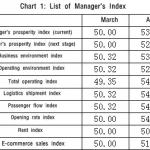
In recent days, on the international level, the conflict between Russia and Ukraine has caused great impacts not only on security and geopolitics, but also directly on the global economy. Recently, economic analysts have not simply mentioned the risk of inflation but instead the concept of “stagflation”, that is, inflation accompanied by a recession, used to refer to conditions of slow economic growth. , high unemployment rate accompanied by rising prices. Vietnam, with an open economy of more than 200% of GDP, the more difficult it is to avoid this risk. In such a general situation, the Vietnam National Textile and Garment Group also has forecasting studies on the economic and market situation affecting the textile and garment industry. Although all forecasts at this time may not be completely accurate, but also give us an overall picture related to the Group’s production activities,
Production and business situation in the first two months of 2022
For the yarn industry
By mid-February 2022, most of the yarn production units in the Group’s system had signed orders until the end of March, a few were sent to April 2022 and are currently actively offering them for sale in the following months. according to. However, when the price of cotton fluctuates erratically plus the price of polyester fiber increases sharply after the Lunar New Year holiday, the yarn consumption market is quite quiet, the demand for yarn for both export and domestic slows down. While still active, customers are waiting and exploring yarn prices, but are not ready to confirm new orders, nor accept new prices.

For the fabric industry
Following the growth momentum in the fourth quarter of 2021, the knitted fabric industry in the first quarter of 2022 is having a strong growth momentum with the core being the textile and dyeing area in the north. Orders have been signed until the end of the second quarter of 2022 with a significant increase in output because the units have invested in more machinery and equipment to improve production capacity. This is also one of the key activities to implement the Group’s “One destination” strategy. However, similar to the yarn industry, customers are not interested in closing orders in the long term, as they are still waiting for signs of cooling off from the yarn market.
For the garment industry
Currently, the majority of garment manufacturing units have planned to produce until the end of the second quarter of 2022. This is a good sign, but the units also need to be very cautious, especially for the garment manufacturers. The unit produces by FOB method because it is expected that the price of raw materials and accessories may increase in the near future. Logistics costs also continue to increase along with slow delivery times, averaging 10 to 15 days compared to before.
In particular, the epidemic situation in February was very complicated, the number of Covid-19 infections increased rapidly, making workers’ psychology unstable and causing labor shortages, some units had up to 15 employees. -20% of workers quit due to the epidemic. This has a great impact on stabilizing production for a labor-intensive industry like the garment industry.
Some market forecasts
Cotton and Fiber Market
Cotton prices in early 2022 increased sharply in all markets, especially in China. In the early days of March, cotton prices tended to level off. Part of that is due to the impact of the Russia-Ukraine conflict, causing investors to turn to commodities with high profit margins such as food and oil. On the other hand, the demand for yarn decreased because the buyers were still listening to the yarn price trend, so they did not close the order. However, the price of cotton is expected to continue to fluctuate unpredictably, but it is likely to remain around the level of about 3 USD/kg.
Fiber price has also increased very high since the fourth quarter of 2021 until now, the average fiber price is over 1.30 USD/kg. Especially, at present, due to scarce oil supply and high oil price, fiber price is forecasted to continue to increase in the coming time.

Yarn Market
At this time, key export markets such as China, Korea, Malaysia, Europe and South America are all quite quiet in terms of both demand and selling price compared to the end of 2021, customers are still waiting. waiting for yarn prices to decrease, but not ready to place new orders for April and May. Prices of carded cotton yarn, TC yarn, and CVC yarn all recorded a slight decrease. This shows that the yarn consumption market has many potential risks, cotton and fiber prices are at a high level, but the offered yarn price cannot increase in proportion to the increase of raw material prices. Some yarn price forecasters are more likely to follow the downtrend if there is no new signal to make the market prosper again. Therefore, the profit margin per 1kg of yarn will be much lower than in the first quarter of 2022, even if the market moves adversely.
Garment market
It is expected that in the third quarter, woven goods such as jackets and trousers may decrease due to the relatively large number of these products remaining at ports. Some garment manufacturers also forecast that orders for knitwear will decrease slightly compared to 2021, while vestons and shirts will be at the same level as 2021. In the following quarters Accordingly, the garment industry continues to face the possibility of slow material arrivals and price increases due to rising costs, and the risk of customers canceling orders if the economic situation worsens.
Logistics continues to increase
The logistics crisis has not shown any signs of cooling down, continues to drag on and the freight rates are creating a new price level. The effects from the Russia-Ukraine crisis, the rapid increase in fuel prices (gasoline, oil, gas, etc.), supply chain and transportation disruptions caused by many major carriers such as Maersk, DHL, UPS have been affected. Temporarily suspending shipping of all orders to Russia… causing sea freight costs and associated surcharges to increase continuously. The shortage of empty containers continues. Exporters do not have the opportunity to choose or negotiate for shipping services like before the pandemic appeared.
Experts estimate that pressure on the global supply chain will continue at least until the second half of 2022. Problems related to operational capacity causing congestion at seaports continue to increase due to the expansion of the global supply chain. growth in consumer demand after the pandemic.
World economy with fragile recovery prospects
The crisis situation in Ukraine has not shown any signs of abating, causing fuel prices to rise over the past two weeks. Thus, after two raging years of the COVID-19 pandemic, the global economy has again faced unpredictable challenges and difficulties, with high oil prices pushing inflation up gallop, and at the same time raising concerns. concerned about the very fragile prospect of a global economic recovery.
According to estimates by the World Economic Forum (WEF), the share of oil in GDP is about 3%. Although not the main driver of inflation, oil is one of the most important commodities in the world. Therefore, the impact of rising oil prices will be found in most of the goods and services that people use, thereby contributing to the escalation of inflation. According to experts, with an average oil price of 110 USD/barrel (ie 60% increase compared to 2021), the consumer price index CPI will increase by 2%. Rising inflation will lead to an increase in exchange rates and interest rates, causing significant pressure on business activities at enterprises.
Possible scenarios that Vietnam’s textile industry needs to identify


Concerned about the rapid and unpredictable fluctuations of the market, the Vietnam National Textile and Garment Group has conducted market research and forecast possible scenarios, in order to help units identify the global picture. situation in the last 6 months of 2022, proactively prevent risks of exchange rate, interest rate, logistics… and soon have solutions to respond promptly, repositioning its competitiveness.
Based on market developments and business practices of the Group’s businesses, the Board of Directors has proposed 3 scenarios for the market in the last 6 months of the year:
- Bad scenario: oil price rises to 150 USD/barrel (equal to the price at the time of economic crisis in 2008), world economy grows by 0%. Accordingly, the inflation rate in the world and Vietnam will be above 5%, the price of input goods will increase, especially transportation and energy. The Fed has 6-7 interest rate hikes, leading to an increase in global interest rates. Total world textile and garment demand may decrease by more than 8% compared to the forecast in February, about 700 billion USD.
- Possible scenario: oil price at 80-85 USD/barrel; global growth falls from 5.7% in 2021 to less than 4% in 2022; inflation in countries increased by 0.5% compared to 2021. The FED may have 4 times to increase interest rates, leading to an increase in domestic interest rates by 1 to 1.5%. Total world textile and garment demand is equivalent to 2021 or 3% lower than the old forecast.
- Good scenario: oil price stands at 75 – 80 USD/barrel; world inflation below 2.5% and Vietnam below 3.5%; interest rates increase about 1 to 1.5%. Total world textile and garment demand increased by 3% compared to 2021.
Solution in the coming period
Oil price in the early days of March 2022 increased gallop, at one point near the threshold of 140 USD/barrel. Thus, we are tending to approach the worst case scenario. The Group’s Executive Authority has also identified a number of solutions to deal with possible situations, in order to proactively manage production activities, manage risks well, and minimize possible damages. . Specifically:
- Promote the implementation of the Group’s “One destination” strategy, in order to link the production chain, proactively source raw materials, optimize production efficiency of the whole chain, and reduce risks if any between stages.
- Find all measures to stabilize labor during the unpredictable epidemic situation.
- The Production and Business Committees need to be more active in timely exchange of market information, prices of raw materials as well as finished products. Acting as a coordinator among units in the Board, developing measures to stabilize raw material prices to prevent risks. In particular, it is necessary to closely monitor the market situation, develop a plan to buy cotton and appropriate input materials.
- Units build backup plans in case the number of orders in the last 6 months of 2022 tends to decrease suddenly. Need to negotiate with customers, balance production plans, ensure enough orders for the last months of the year.
- For the yarn industry: consider producing high-cost yarns, blended yarns to increase added value for products, and maintain a reasonable profit margin per 1kg of yarn.
- For the garment industry: consider a reasonable ratio between CMT and FOB production, avoid risks due to rising interest rates, high prices of raw materials and difficulties in logistics.
- Quickly perfecting the digital management system throughout the Group, helping to control production and business activities quickly and effectively, and propose flexible response measures to market fluctuations.
- The Group’s functional departments need to quickly study the Government’s economic recovery support programs and guide businesses in the procedures to be able to take advantage of these support packages.
Responding to unpredictable fluctuations in the coming period, the most important thing is that the enterprises in the Group must stay calm, master information, handle flexibly and decisively. At the same time, it is necessary to promote the tradition of solidarity, share information transparently, to ensure the promotion of the collective strength of each Business Department as well as of the entire supply chain of the Group. With that, we believe that together, we will overcome all obstacles and successfully implement the business plan in 2022. (Source: VINATEX)





